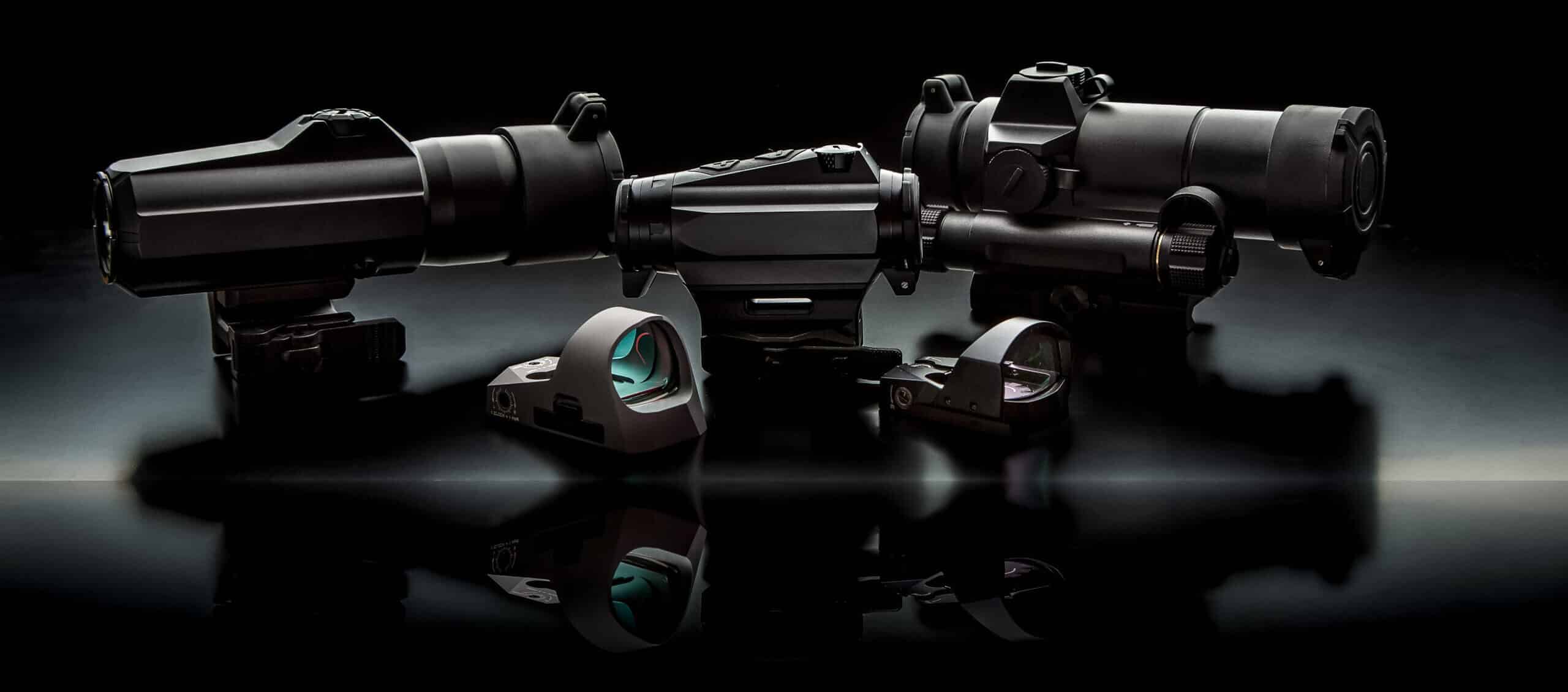Beginner’s Guide to Firearm Optics

Whether you’re outfitting your first rifle or upgrading a home-defense pistol, picking the right optic can feel like stepping into a world of confusing acronyms and high-dollar gear. But optics don’t have to be intimidating. In fact, the right optic can make you a better, safer, and more confident shooter—whether you’re at the range, in the woods, or protecting your home.
This Beginner’s Guide to Firearm Optics breaks down the different types of sights, what they do, who they’re for, and how to make an informed decision without blowing your budget.
Why Optics Matter
Firearm optics have become essential tools for shooters of all experience levels. Here’s why:
- Faster Target Acquisition: Optics help you aim faster, especially under stress.
- Improved Accuracy: Whether it’s a red dot at 15 feet or a rifle scope at 300 yards, optics reduce guesswork.
- Adaptability: The right optic allows you to optimize your firearm for your mission—home defense, hunting, bug out, or target shooting.
- Accessibility: For those with aging eyes or visual impairments, optics can compensate where iron sights fall short.
Types of Firearm Optics Explained
Our Beginner’s Guide to Firearm Optics will break down the main categories of optics, what they do, and when you’d want to use them. (We’ll go deeper into each of these in follow-up Intel Drops.)
Red Dot Sights (Reflex Sights)
Best For: Home defense, competition shooting, short-range shooting (0–100 yards).
Use Case: Mount it on an AR-15, PCC, shotgun or sidearm for quick and intuitive aiming.
A red dot sight projects a simple illuminated dot (or reticle) onto a lens. There’s no magnification—what you see is what you get. Just place the dot where you want the bullet to go. Red dot sights place the target and the reticle (the dot) on nearly the same optical plane, allowing for single point of focus. This makes for fast and intuitive target acquisition.
“Unlike iron sights, which demand switching focus between the sights and the target, a red dot lets you stay target-focused—something invaluable in high-stress situations, such as home defense.” – Scott Witner “Pistols and Red Dots for Home Defense | Reliable Picks” AmmoLand, May 5, 2025
- Pros:
- Extremely fast to acquire targets
- Lightweight and compact
- Works great with both eyes open
- Nearly unlimited eye-relief
- Cons:
- Not ideal for long-range shots
- Requires batteries (though battery life is usually measured in years)
- Individuals with astigmatism may experience distortion of the red dot reticle
Prismatic Optics
Best For: Mid-range shooting, bug-out rifles, shooters with astigmatism.
Use Case: Great for 100–300 yards with a fixed 3x or 5x magnification.
Prismatic optics offer fixed magnification in a compact form. Instead of a red dot projected on glass, they use an etched reticle, which remains visible even if your battery dies. That makes them reliable in SHTF scenarios.
- Pros:
- Battery not required for reticle visibility
- Crisp, clear image
- Often has a BDC (bullet drop compensator) reticle
- Cons:
- Narrower eye box than red dots
- Can be less flexible with fixed magnification
- Generally larger, and heavier, than their red dot counterparts
Rifle Scopes (Magnified Optics)
Best For: Hunting, long-range shooting, precision target practice.
Use Case: Dial in a deer at 200 yards or ring steel at 600.
Rifle scopes are the most traditional optics, offering variable zoom (like 3-9x or 4-16x) and complex reticles for adjusting for wind and bullet drop. Magnified optics increase the apparent size of objects when viewed from a distance, allowing for more detail and aiding in target identification. Because the magnification can be adjusted, rifle scopes are more versatile over multiple distances and in different scenarios.
- Pros:
- Accurate at distance
- Wide selection of reticle types
- Great in daylight and low-light conditions with the right glass
- Cons:
- Slower to acquire targets at close range
- Often heavier and bulkier
- Field of view decreases as magnification increases
- Price – they don’t have to be expensive, but quality glass usually is
Holographic Sights
Best For: Tactical use, law enforcement, serious shooters.
Use Case: Perfect when speed matters but durability and reticle clarity also count.
Holographic sights (like those made by EOTech) use laser technology to project a holographic reticle onto a glass lens and into your field of view. They’re often more rugged than red dots and allow for faster follow-up shots. They allow the shooter to keep both eyes open, improving peripheral vision and reaction time. And unlike red dot sights that become less useful over distance, holographic sights can be used at virtually any distance. If you can see the target without magnification, a holographic sight will work.
- Pros:
- Reticle remains clear even with broken glass or partial obstructions
- Parallax-free
- Advances reticle options and good low-light performance
- Better for shooters with astigmatism than red dots
- Cons:
- Higher complexity means a higher price point
- Shorter battery life
- Increased weight and bulk
Thermal and Night Vision Optics
Best For: Night hunting, surveillance, grid-down scenarios.
Use Case: Spot hogs in a field (or from a helicopter) or monitor property in total darkness.
Thermal and night vision optics offer distinct advantages in various use cases. Once the domain of special operations and high-end military units, these technologies are becoming more common in civilian sectors. Thermal imaging excels at detecting heat signatures, enabling clear visibility in total darkness and through obstructions like fog or foliage. Night vision, on the other hand, amplifies available light, providing a more natural, detailed view in low-light conditions. While both are excellent tools in their own right, they truly excel when used together.
Thermal optics detect heat signatures. Ideal for spotting animals or intruders, regardless of ambient light. Thermal optics will work in virtually any conditions, at any time of day.
- Pros:
- Not affected by ambient light – use it any time of day, in any conditions
- Detects body heat – useful for detecting intruders or finding lost persons
- Can penetrate fog, smoke, and thick foliage
- Offers superior long range detection versus night vision
- Cons:
- Cost – often more expensive than night vision
- Lacks detail and image clarity
- Heavy and power-hungry
- Typically cannot see through glass or other opaque materials
Night Vision amplifies light to give a green-hued image in low-light conditions. Night vision scopes offer significant advantages for low-light or dark-vision, improving visibility and safety, especially during night hunting or shooting.
- Pros:
- See in near-darkness
- Provides a more natural, detailed image versus thermal
- Wide field of view
- Excels at close-to-mid range visibility
- Cons:
- Expensive ($1,000+ for decent models)
- Heavy and power-hungry
- Can be affected by environmental conditions (heavy cloud cover, fog)
- Not as effective in complete darkness as thermal
- Lack of contrast can make target identification challenging in some scenarios
Iron Sights (They’re Still Relevant!)
Before we move on—don’t forget about iron sights. They’re passive, don’t require batteries, and are a must-have backup in any serious setup. Train with them. Know them. Rely on them when tech fails.
Choosing the Right Optic for Your Needs
This beginner’s guide to firearm optics is a great starting point, but there is no “best optic”—only the best one for your use case. Here are some examples:
Home Defense
You want speed, reliability, and wide field of view. A red dot or holographic sight mounted on a rifle or pistol-caliber carbine (PCC) excels here.
Bug-Out / Preparedness
Consider battery-free options like prism scopes with etched reticles or compact rifle scopes. They’re durable and don’t rely on electronics.
Range Shooting / Training
If you’re mostly punching paper at 100 yards, go with a red dot or prism scope. For longer range or precision shooting, use a variable rifle scope.
Hunting
Use a magnified rifle scope with good low-light performance. In states where night hunting is legal, thermal optics can be a game-changer.
Tactical / Law Enforcement Use
Holographic sights or high-end red dots are popular due to their ruggedness and ability to co-witness with iron sights.
Mounting Basics: What New Gun Owners Need to Know
Mounting your new optic is generally straightforward, and most optics sold these days come with some kind of mount out of the box. Magnified optics, like rifle scopes, are an exception to this and typically require purchasing a separate mounting system. We’ll get into more detail in a future Intel Drop, but for now here are some mounting basics to keep in mind.
Mounting Systems: Virtually all optics mount on Picatinny or Weaver rails. Most optics, particularly red dot sights, holographic sights, and prismatic sights, will come equipped with a basic Picatinny mount. These mounts will be compatible with virtually any modern rifle, carbine, PCC, etc. Magnified optics like rifle scopes, typically mount with “scope rings” which in-turn mount to Picatinny rails; often these are not included with the rifle scope
- Picatinny rails are a standardized rail system – most optics will come equipped to mount to a Picatinny rail
- Weaver rails are less common than Picatinny rails, especially for newer firearms and accessories
- Note that Picatinny accessories will not fit on a Weaver rail, but Weaver accessories will fit on a Picatinny rail.
- Rifle Scopes do not generally come with mounts. The most common mounts are called “scope rings” which are sized to fit the body of your scope, and in turn usually mount to a Picatinny rail.
- Quick-Detach Mounts let you remove optics on the fly without losing zero
- Co-Witnessing refers to mounting a red dot or holographic optic with iron sights, allowing both to be used simultaneously
Final Thoughts for New Gun Owners
Choosing your first optic doesn’t have to be a guessing game. Stick with a reputable brand, match it to your mission, and train consistently. An optic is only as good as the shooter behind it.
If you’re unsure where to start after reading our Beginner’s Guide to Firearm Optics, keep it simple and consider:
- A simple red dot for home defense
- A 3x prism scope for bug-out or range use
- A variable scope for hunting or long-range shooting
What’s Next in This Series
In our next Intel Drops we’ll break down each optic type in more detail:
- Red Dot Sights Explained
- Prismatic Scopes and Their Advantages
- Choosing Your First Rifle Scope
- Holographic Sights Demystified
- Thermal and Night Vision for Civilians
Bookmark this guide and check back for updates as we dive deeper into each topic.

